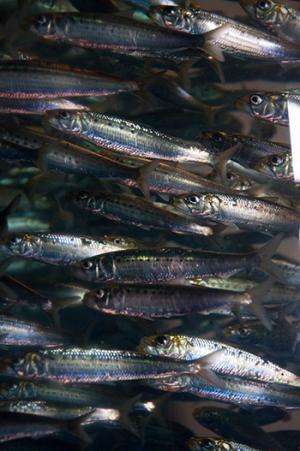Coastal power plant records reveal decline in key Southern California fishes

Recent research documents a dramatic, 40-year drop in a number of key fish species and a change in their community structure, according to a new study led by Eric Miller of MBC Applied Environmental Sciences (Costa Mesa, Calif.) and John McGowan of Scripps Institution of Oceanography at UC San Diego.
As described in the July 20, 2013, issue of the journal Estuarine, Coastal and Shelf Science, the researchers tapped into a vast, yet nontraditional source of information to formulate their conclusions: An expansive catalog of fish captured and recorded in cooling water systems at five California coastal power plants.
The unique data set is derived from the tens of millions of cubic meters of water filtered at each power plant several times per year. Each fish caught by the cooling systems since 1972 was identified and counted.
The power plant data are another component in the various methods Scripps scientists employ to help science and society understand environmental issues and challenges. Scripps's longstanding oceanographic observation programs include the California Cooperative Oceanic Fisheries Investigations (CalCOFI), the longest open-ocean observing program of its kind that has been producing vital data to decipher changes well offshore, as well as a long-standing program of daily seawater measurements off the Scripps Pier. The CalCOFI program has also shown long-term declines in plankton abundance. Such observational sources are part of a foundation for research to better understand the ocean environment and provide benefits to ocean managers, decision makers, and others.
The bulk average of fish from the early power plant recordings (1972-1983) declined by 78 percent compared with more recent years (1990-2010). The findings, according to the scientists, tend to absolve overfishing as the main culprit in the decline of these fishes because both commercial fish species as well as non-commercial fishes suffered similar population drops.
The decline centers on so-called "forage" fishes, small species such as sardines and anchovies that live close to shore and are consumed by larger predatory fish, seabirds, and marine mammals.
"Many of the species represented in this data set are rarely reported on as they are not targeted by either recreational or commercial fisheries, yet their decline was commensurate with better known species such as anchovies and sea basses," said Miller. "Recent data collected since this analysis was completed do not change the outlook—the relatively long-term decline continues and likely contributes to the current, acute malnutrition and mortalities in California sea lions."
"The data indicate that there has been a clear-cut and substantial decline in the abundance of these forage fish, both in the number of fish caught and in the overall biomass," said McGowan, an emeritus research professor of oceanography at Scripps. "Factors beyond fishing such as oceanographic change appear to be involved, including temperature changes from global warming."
McGowan says the evidence reveals clear synchronous declines across all five regions, possibly connected to ocean temperatures. Ranging from Northern San Diego County to Ventura County, the power plants include the San Onofre Nuclear Generating Station, Huntington Beach Generating Station, Redondo Beach Generating Station, El Segundo Generating Station, and Ormond Beach Generating Station.
"The data from four of the five power plants agree with one another, so it has to be a large-scale phenomenon, something other than the individual power plants," McGowan said.
"We have found consistency between the power plant records and data compiled from other independent sources including fishing records and stock assessment models," said Miller. "This invaluable secondary use of the power plant monitoring program provides population data to help better manage our coastal resources. It is a benefit which we have only begun to utilize."
Provided by University of California - San Diego




















